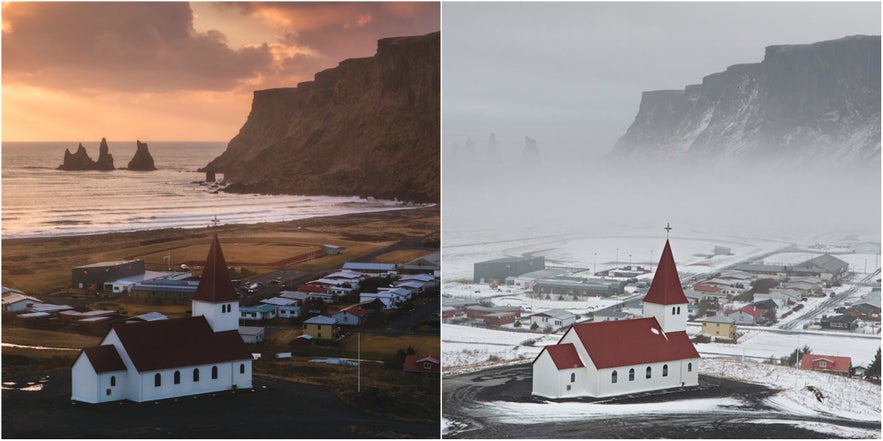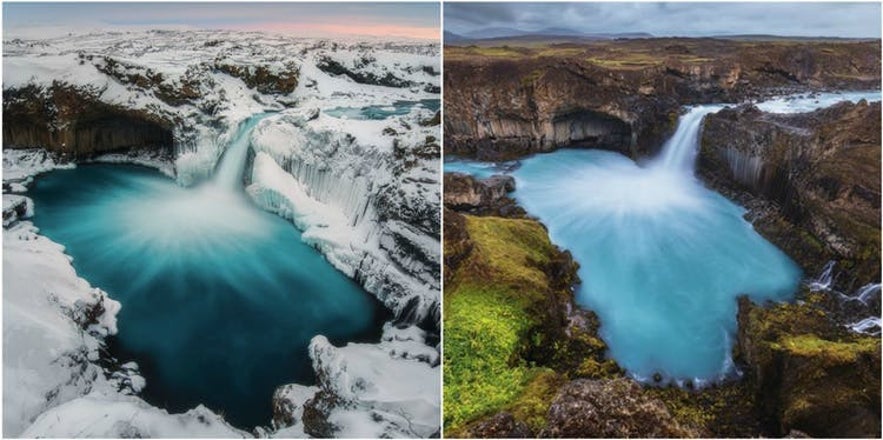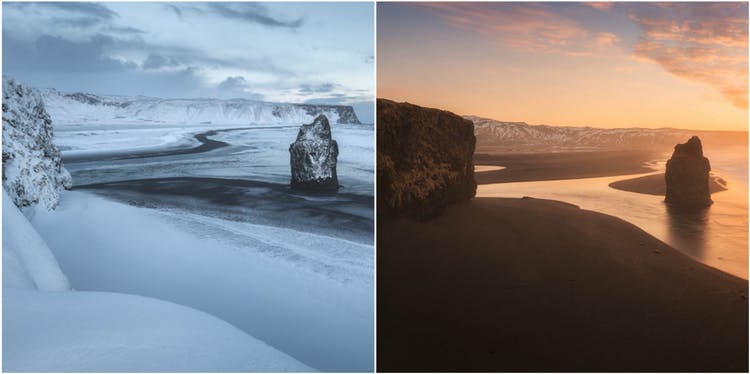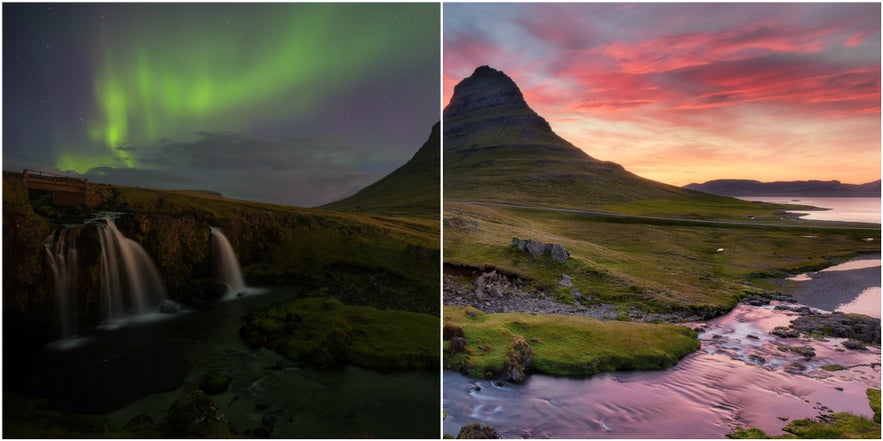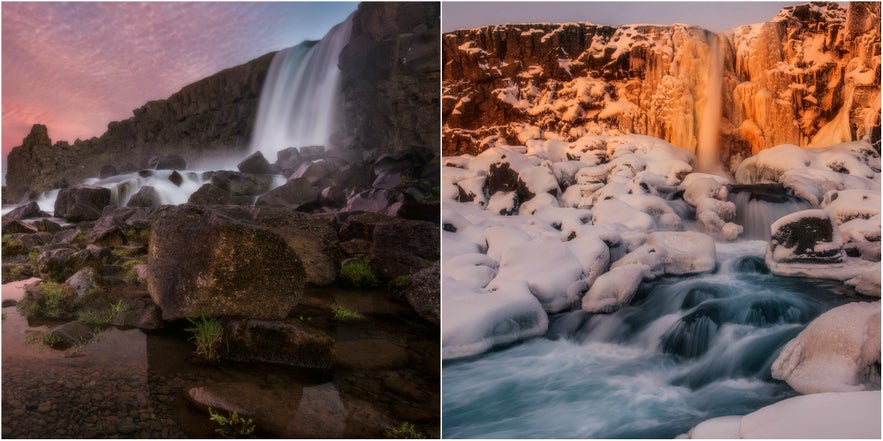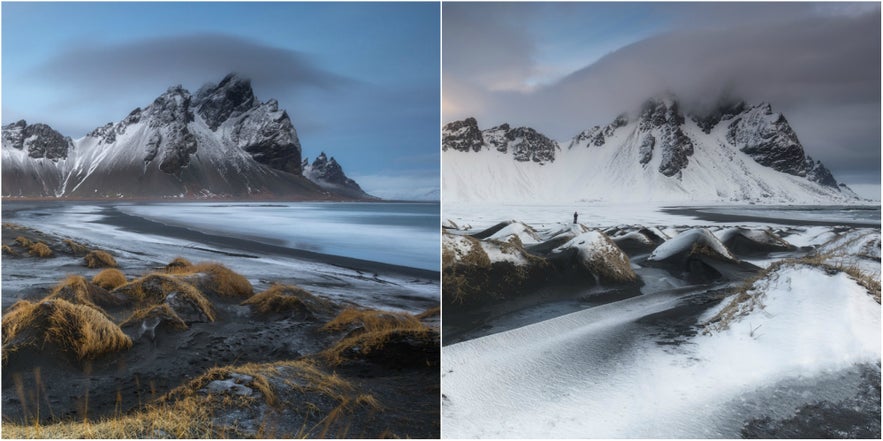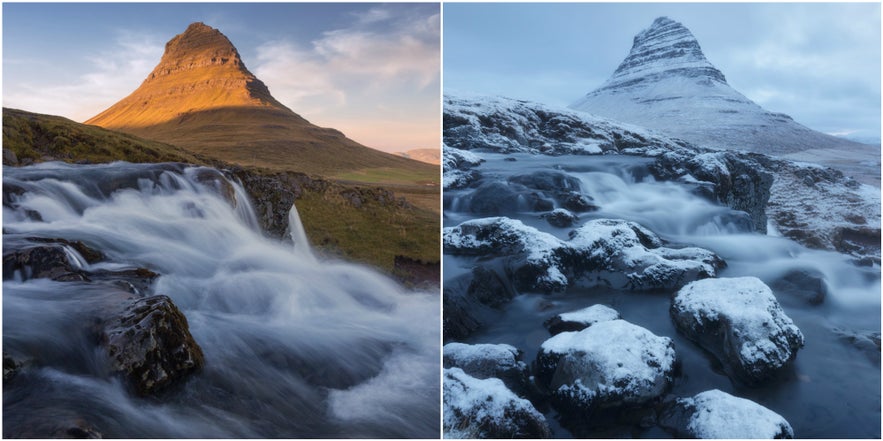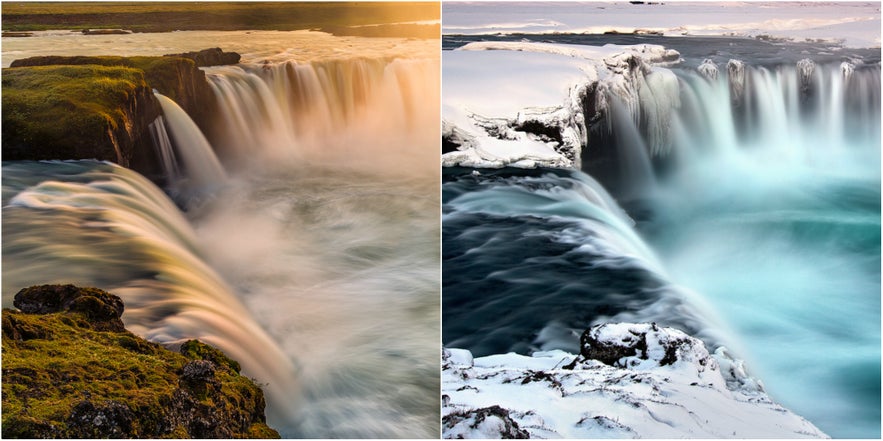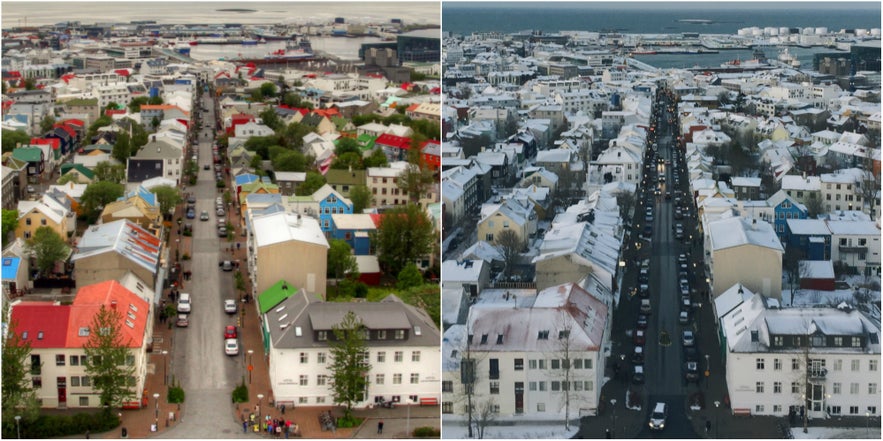
Iceland's Seasonal Contrasts

What are the differences between the seasons in Iceland? Why don’t Icelanders recognize autumn or spring, and what is the best season to travel? What are the benefits of traveling in winter compared to summer? Discover all you need to know about Iceland between the seasons.
Each time the earth’s axis tilts, nature repaints Iceland with a new and dramatic palette; already a land of staggering physical contrasts, Iceland’s seasonal weather often makes it feel like two countries rather than one, providing multiple opportunities for visitors to experience something new whilst traveling here.
Whatever you’re looking for, be it heart-pumping adrenaline, fantastic scenery, cultural and artistic inspiration or simply a relaxing time, Iceland will more than meet your expectations, regardless of the season. The challenge comes not in finding things to do, but in prioritising what you can in the time available; thankfully, many of Iceland’s most popular attractions, such as horseback riding and snorkelling, are available the year-round, thus giving you more options as to when to travel.
To illustrate the astounding differences that seasonal changes bring upon Iceland, a number of location photographs are included in the below article which will show how the country appears at different points throughout the calendar year.
- See Also: Weather in Iceland & Best Time to Visit
Iceland’s Geographical Position
Consider, if you will, Iceland’s position on the world atlas; smack bang between the North American and European continents, Iceland (63-67°N and 18-23°W) sits isolated in the North Atlantic Ocean, its nearest neighbour being Greenland, to the east. The country sits immediately south of the Arctic Circle, with the island of Grímsey being the only Icelandic territory that comes’ within the circle’s boundary. Due to the gradually changing position of the Arctic Circle, Grímsey will fail to make the cut come mid-century.
The Gulf Stream flows across the country’s eastern and western coasts, creating a more temperate climate in Iceland than its name suggests. In fact, many often point out that Iceland and Greenland should swap names, not a bad suggestion if one were to consider the climate, flora and fauna of each territory. After all, three-quarters of Greenland is covered by the largest permanent ice sheet outside of the Antarctic, whilst Iceland is a sprawling, eclectic landscape defined by its hills, volcanic meadows, mountain ranges and coastlines.
Iceland’s overall geographical position is the reason behind why the country experiences both the Midnight Sun and its opposite, a Polar Night, for long periods each year. Iceland’s high latitude on the globe also means it within the sightline of the Aurora Borealis, otherwise known as the Northern Lights.
Both the Midnight Sun and the Northern Lights are experiences that are major attractions for those visiting Iceland for the first time, given that the vast majority of the planet will never experience such events.
- See Also: Midnight Sun in Iceland
Travelling to Iceland in Winter
At the earth’s higher latitudes, a country’s inhabitance can experience a solar phenomenon known as the Aurora Borealis, referred to colloquially as The Northern Lights. Solar activity is not restricted just to the north, however; in the south, this phenomenon is known as the Aurora Australis or the Southern Lights.
- See Also: Northern Lights in Iceland
As it's a natural phenomenon, visitors to Iceland hoping to experience the Northern Lights may not experience anything at all; they are, after all, notoriously elusive. Despite enormous technological breakthroughs in meteorology and climate science, it is still impossible to predict for sure when the Northern Lights will appear.
However, excellent predictions can be made, and Northern Lights tour operators in Iceland are amongst the most knowledgeable and experienced individuals when it comes to tracking them down. Not only will partaking in a Northern Lights tour increase your chances of seeing the Lights, but you will also learn about the solar system, Icelandic culture and the Aurora itself.
For those who plan to hunt the Northern Lights themselves, be prepared to travel out of Reykjavik’s borders, escaping artificial light so as not to pollute the Aurora Borealis' visibility. For those who manage to spot them, they will be privy to a cosmic display of purple, red, yellow and green waves, dancing majestically through the night sky.
- See Also: The Ultimate Winter Itinerary for Iceland.
Winter, of course, is the only time to see the Northern Lights, as daylight dilutes the Aurora so that it is invisible to the human eye. The winter months do see another far more regular phenomenon that occurs, however, the daily “Golden Hour”.
This period, often longer than an hour, is when the sun finally breaks over the horizon line, hovering there precariously until descending once again. Throughout this time, Iceland is blanketed with a radiant pink and golden light, presenting fantastic photographic opportunities to snap the sunrise and sunset.
Naturally, there are a wealth of other activities available during the winter months in Iceland, least of all those specifically designed for such conditions. For example, did you know that you can go dog-sledding in Iceland? Glacier hiking and ice-caving? Snowmobiling? Skiing and Snowboarding? All of these winter activities make for incredible memories, and often add a sense of seasonal authenticity to your trip.
- See Also: Best Winter Activities in Iceland
- See Also: What to Pack for Travel in Iceland
In January, the average temperature in Reykjavík is -0.5°C /31°F, though, in reality, windchill makes the air feel much colder. To combat it, visitors and locals alike should prepare to dress sensibly; multiple layers of socks, thermal trousers, rain jackets, hoodies, hiking boots, beanies... with some forethought, all of these should be found neatly packed in your luggage, saving you the embarrassment of navigating the ice in flip-flops.
Travelling to Iceland in Summer
The summer months coincide with Iceland’s peak tourism season, May to September. The first official month of summer in Iceland is June, though, by that time, the weather has well and truly turned the other cheek.
In fact, Icelanders celebrate "Sumardagurinn fyrsti" ("the first day of summer") on the first Thursday after April 18th every year. Though a premature celebration—not complete without sports matches, parades and cultural exhibitions—it does perfectly demonstrate the Icelander's enthusiasm to see winter well and truly behind them.
- See Also: Iceland in June
One of the major highlights of traveling to Iceland in summer is the chance to see the widely-discussed Midnight Sun. For those who have not heard of this enigma, the “Midnight Sun” describes when the sun stays out throughout the night (or near enough), leading to longer days and a rush of conscious energy from the local population. From May to July, the sun is above the horizon line for almost twenty-four hours.
The country's longest day falls around June 21st, known as the summer solstice. On this day, the sun rises at around three in the morning and sets just after midnight. With all of that extra daylight, visitors to Iceland can truly maximize the opportunities and experiences available to them.
For instance, most travelling to Iceland will stay at accommodation in the capital and rent a car to see some of the further attractions. Truly beautiful spots, however, such as Jökulsárlón Glacier Lagoon, require an almost ten-hour round trip, more than enough driving for a single day.
By travelling in summer, guests have more time to organise their day slowly, making multiple stops along the way without fear that the sunset might ruin their sightseeing. It is also the safer option for drivers wary of taking to the winter's ice-laden roads.
Elsewhere across the country, visitors can attend other such events as the Ein með öllu festival in Akureyri (August), Bræðslan Music Festival in Borgarfjörður Eystri (July) or Þjóðhátíð í Eyjum in the Westman Islands (August). The list goes on and on, but more information can be found in our Top 20 Festivals in Iceland article.
As for activities, summer in Iceland means adventure; with the vast majority of tours open and available, visitors can partake in experiences as far-ranging as mountain hiking to scuba diving to driving ATV's. Unlike winter, the roads to the Central Highlands are now open, meaning people are free to explore and hike the bright and gorgeous hiking trails of Landmannalaugar. Check out which tours might best suit your tastes at the Guide To Iceland tours page.
- See Also: The Ultimate Itinerary for Iceland
Where are Autumn and Spring?
Of course, Iceland experiences autumn and spring-like everywhere else on the planet; the major shift lies in the seasons’ noticeability. The sheer polarity between summer and winter here means that what lies between often feels little more than a short bout of milder weather.
- See Also: Time In Iceland | A Land of Here and Now
- See Also: Cafés in Reykjavik | A Guide to Icelandic Coffee Culture
Naturally, those sensitive enough will recognise the subtle details of these ‘mini-seasons’; in spring, flowers begin to creep across a tundra still scarred by the winter’s snowfall, as birds and young wildlife, again, begin to populate the landscape. The sun begins to appear more habitually, staying longer and intensifying its heat, yet still clings to a stubborn, yet dissipating cover of cloud.
In Autumn, the sun quickly retreats, thrusting Iceland into a world of growing, rustic darkness; little by little, the leaves crispen and change colours, the winds strengthen and the temperature drops. Reykjavik’s streets are suddenly filled with mist-breathing, scarf-wearing people, unified in both their triple-layered, woollen attire and desperation for a Te & Kaffi cappuccino.
- See Also: Photography in Iceland
As the nights stretch on into the morning, then the late-morning, then past lunch, one’s memories of summer feel faint and somewhat surreal, overcome with a foreboding sense that winter, truly, is coming.
Summer and winter sneak up on you here; one will spend days, weeks, months, worrying about the oncoming winter darkness, only to realise that they’re knee-deep in snow, fully bearded and donning ski goggles. So too with summer; the first day of putting on a pair of shorts is often premature, whilst the last day is always too late.
In truth, however, it really doesn't matter too much which season you decide to travel to Iceland—unless, of course, you're set on seeing the Northern Lights or the Midnight Sun—as each offers its own qualities that are bound to enchant you. Regardless of summer, winter, autumn or spring, the Icelandic people will make you welcome, and show you firsthand just how much fun can be had in any weather.
Just make sure to pack the right clothes.
Which was the season in which you travelled to Iceland? Have you travelled here in both the winter and summertime and, if so, which was your favourite? Please feel free to leave comments and queries in the Facebook box below.
Andre interessante artikler

Den Ultimate Guiden til Island i August
Finn ut alt du trenger å vite om å besøke Island i august i denne omfattende guiden. Lær om hvilke dyr du kan se, hvordan været er i august, hvilke steder som er verdt å besøke og om du vil kunne se n...Les mer
Den ultimate guiden til isgrotter på Island
Lær alt du trenger å vite om isgrotter på Island. Hvor er de beste isgrottene? Hvordan kan du besøke dem? Og hva er forskjellen på en isgrotte og en bregrotte? Les videre for å lære alt om Islands f...Les merBesøk Island i mai | Ting du kan se og gjøre
Oppdag hvorfor du bør reise til Island i mai. Lær mer om været på Island i mai og hvilke aktiviteter du kan gjøre mens du er der. Så les videre og utforsk de beste tingene du kan se og gjøre på Isla...Les mer

Last ned Islands største reisemarkedsplass på telefonen din for å administrere hele reisen på ett sted
Skann denne QR-koden med telefonen din og trykk på lenken som vises, for å legge til Islands største reisemarkedsplass. Legg til telefonnummeret ditt eller e-postadressen din for å motta SMS eller e-post med nedlastingslenken.
